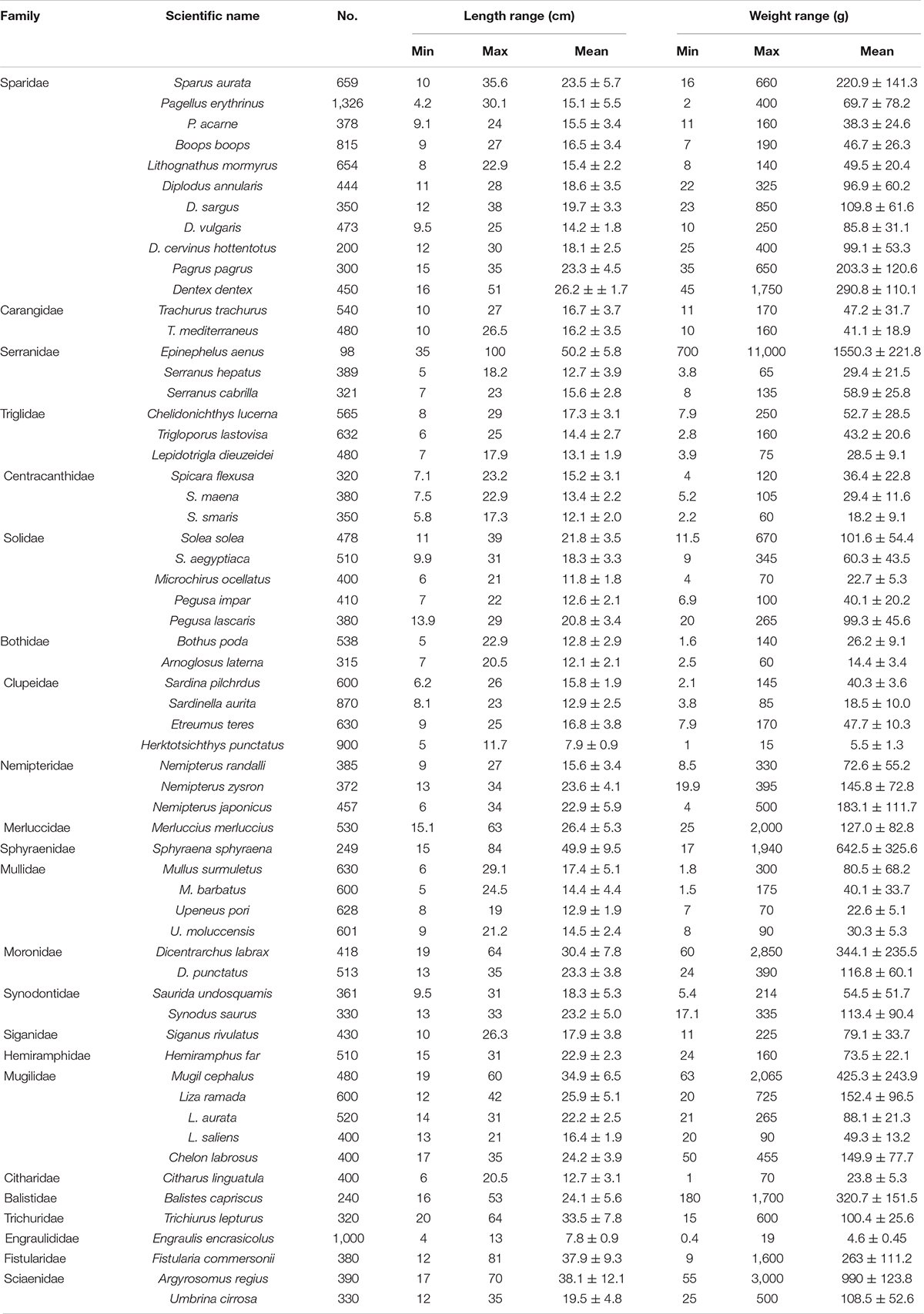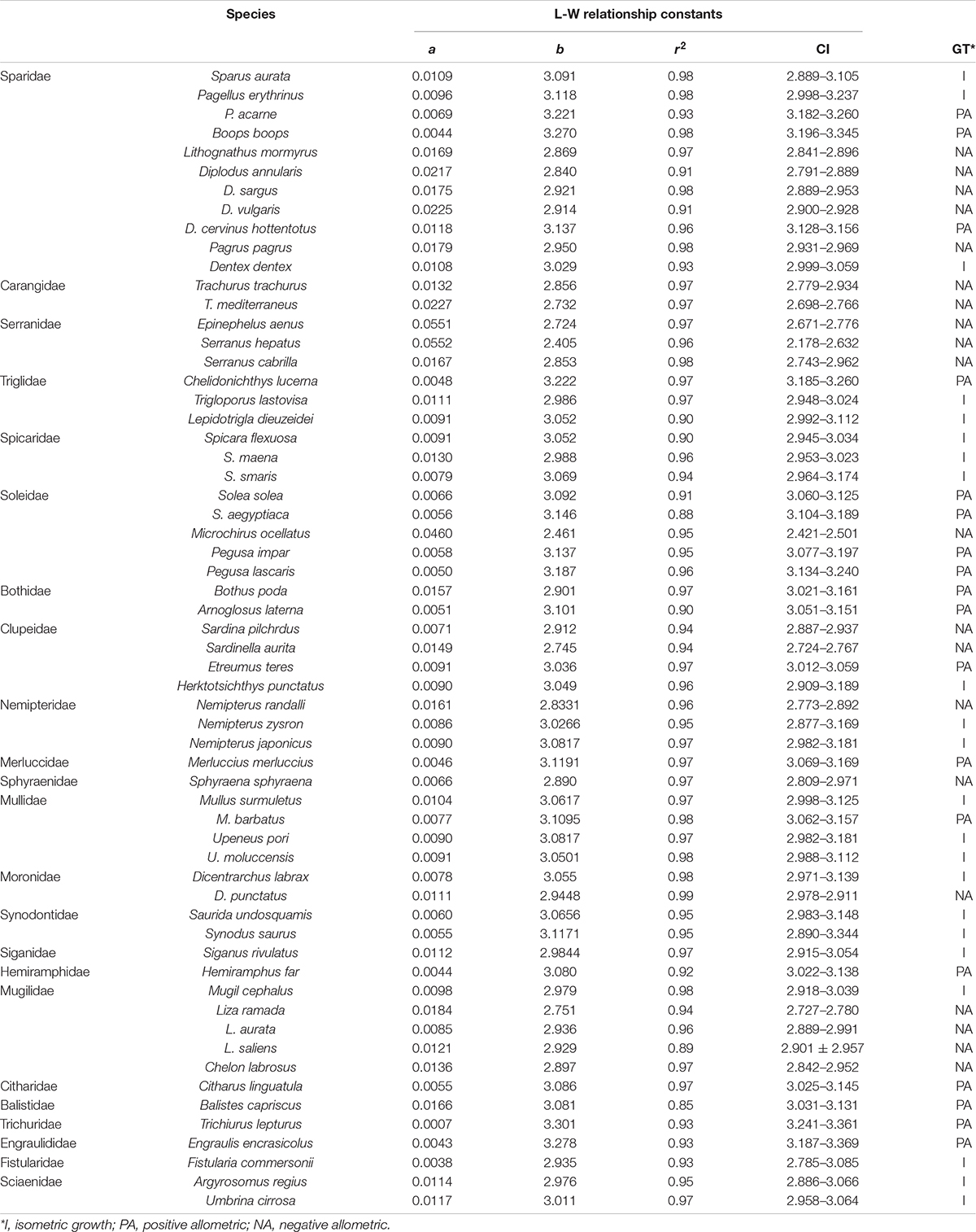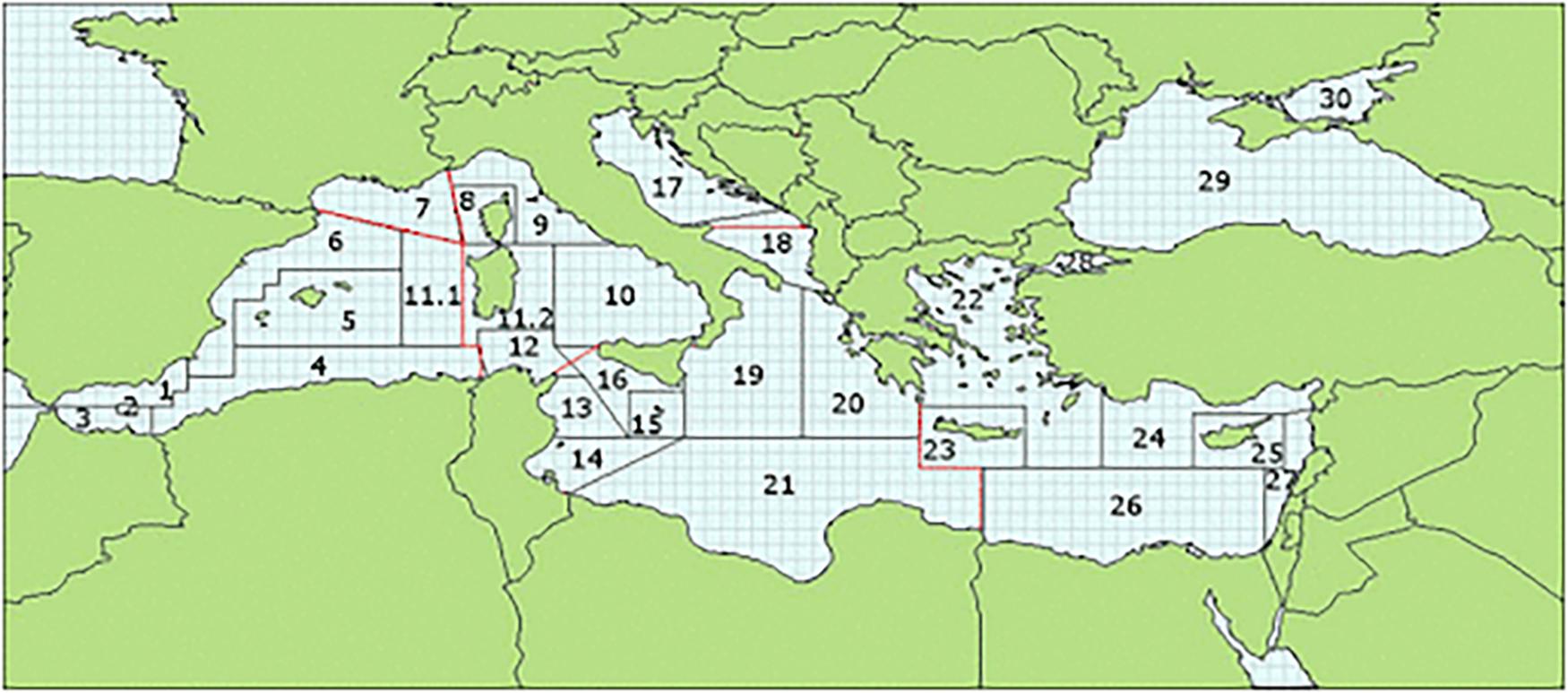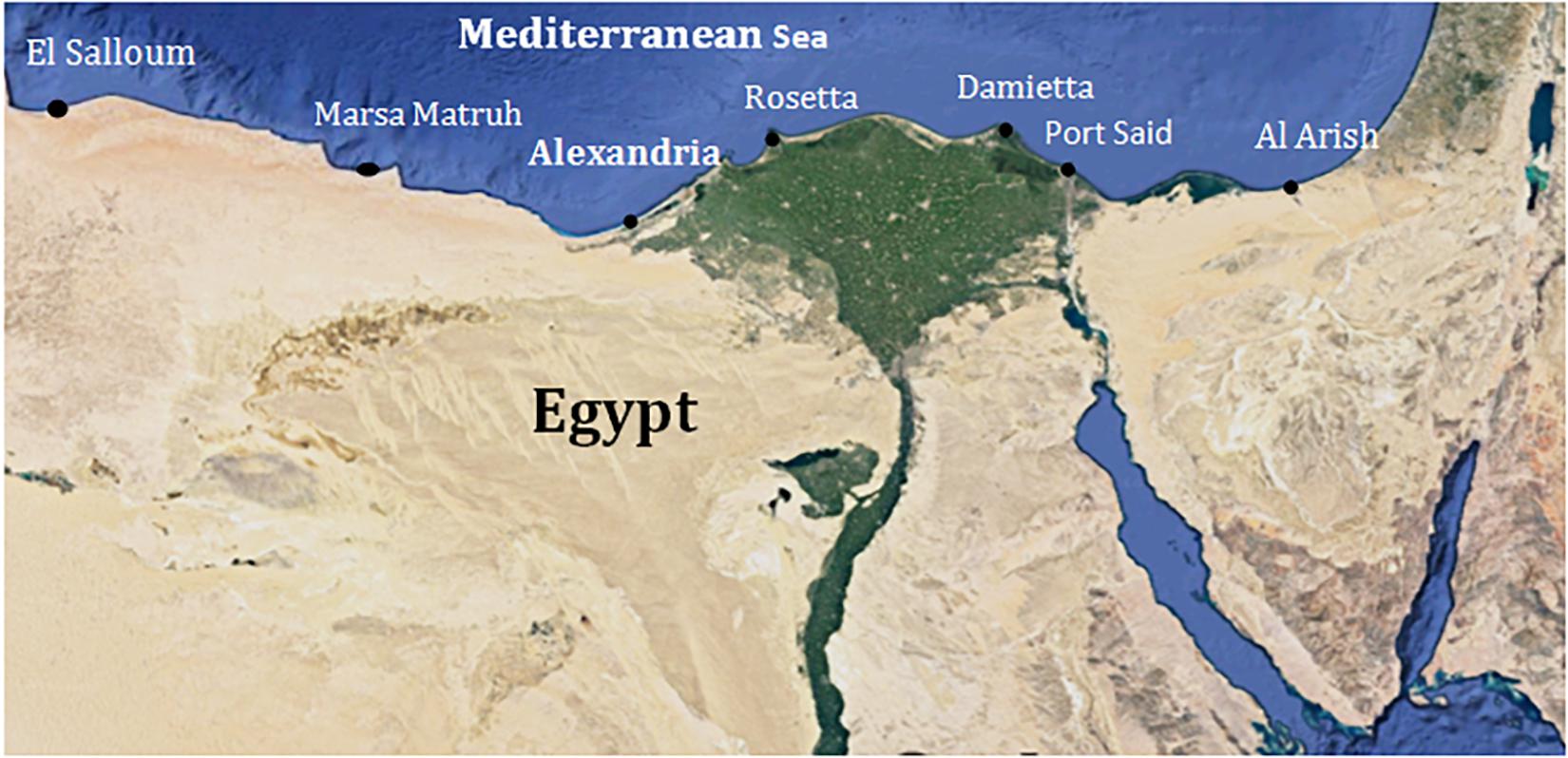- 1Fish Population Dynamics Lab, National Institute of Oceanography and Fisheries, Suez, Egypt
- 2Central Laboratory for Aquaculture Research, Abbassa, Egypt
Length-weight relationships (LWRs) are described for 60 important pelagic and demersal fish species caught during fishing surveys using trawl fishing gear in the Eastern Mediterranean, Egypt (General Fisheries Commission for the Mediterranean GFCM-GSA 26), and the data collected from the commercial catch during the period from July 2017 to December 2018. Linear regression using natural logarithmic transformation data was performed to calculate the a and b coefficients of LWR for 60 fish populations covering 23 families, 43 genera, and 60 species inhabiting GSA 26. The samples size, minimum and maximum lengths and weights with their mean and SD, LWR constants, ± 95% confidence interval (CI) of b, r2, and the type of growth were calculated and summarized. This study reports the first LWR estimates for 35 species in the Egyptian waters of the Mediterranean Sea.
Introduction
Egyptian fisheries contribute a great deal to food security and therefore play a very important role in the economy of the country. In Egypt, there are three main fish resources: marine fisheries (the Mediterranean and the Red Seas), inland fisheries (lakes and the Nile River), and aquaculture. Fisheries and aquaculture supplied Egypt with 1.9 million tons of fish in 2018, mostly used for domestic consumption. Egypt has two separate Exclusive Economic Zones (EEZs): one of 169,125 km2 in the Mediterranean with a shelf area of 31,017 km2, and the other of 91,279 km2 in the Red Sea with a shelf area of 23,180 km2α. The Egyptian marine fisheries yield up to 100,000 tons of a large variety of commercial fish, Mollusca and Crustacean species (62,000 and 38,000 tons from the Mediterranean and the Red Seas, respectively).
The Egyptian Mediterranean coast is divided into four main fishing grounds namely; the Western region (Alexandria and El-Mex, Abu-Qir, Rosetta, El-Maadiya, and Mersa Matrouh), the Eastern region (Port Said and El-Arish), the Damietta region, and the Nile Delta region (General Authority for Fish Resources Development, 2018).
Demersal fishes are important species landed by the industrial and the artisanal fleet from the Egyptian coastal waters of the Mediterranean Sea constituting about 33% of total fish yield in Egypt (Statistical fish book, 1991–2018). This is equivalent to about Egyptian 1,500 million Egyptian pound per year (about or ≈ 100 million US$). While the small and large pelagics and semipelagics constitute about 67% of the total fish yield from the Egyptian Mediterranean, achieving about 2,000 million LE (about or ≈ 133 million US$) (Mehanna, 2019a).
To estimate the biomass of different fish populations, it is necessary to know the length-weight relationships (LWRs) of the studied species. LWR is of great importance in fish stock assessments (Garcia et al., 1989; Haimovici and Velasco, 2000). Length and weight measurements in conjunction with age data can give information on the stock composition, age at maturity, life span, mortality, growth, and production (Diaz et al., 2000; Frota et al., 2004; Froese, 2006). For fish, size is representative of age, diet, and other physiological and environmental factors. Theoretically, size is representative of age because fishes never cease to grow in size and size is dependent on external factors, not the opposite. Consequently, variability in size has important implications for diverse aspects of fisheries science and population dynamics (Erzini, 1994). Length-weight regressions have been used frequently to estimate weight from length because direct weight measurements can be time-consuming in the field (Sinovcic et al., 2004). Generally, LWR of fish is used to estimate the wellbeing of fish, its biomass from length observation, the conversion of growth in length equations to growth in weight, and it is also useful for between-region comparisons of the life history of species (Pauly, 1993; Goncalves et al., 1997; Binohlan and Pauly, 1998; Stergiou and Moutopoulos, 2001).
In this study, the LWRs were estimated for 60 demersal and pelagic fish species that are the most dominant and commercial species caught from both the bottom survey and the commercial catch in the Egyptian Mediterranean GSA 26 (Figures 1, 2).
Materials and Methods
The length and weight measurements were recorded during the bottom trawl surveys in the Mediterranean Sea of Egypt during the period from April 2008 to July 2010 and were updated by collecting and measuring more samples from the commercial catches along with the landing sites during the period from July 2017 to December 2018.
A total of 30,596 fish of 60 fish species were measured and weighed. The total length (cm) of each fish was measured from the tip of the snout (mouth closed) to the extended tip of the caudal fin using a measuring board. Bodyweight was recorded to the nearest gram using a balance. The LWRs were estimated from the allometric formula, W = a Lb (Le Cren, 1951), where W is total body weight (g), L is the total length (cm), a and b are the coefficients of the functional regression between W and L (Beckman, 1948; Ricker, 1973). The values of constants a and b were estimated by the least-square linear regression from the log-transformed values of length and weight: log W = log a + b log L (Zar, 1984; Stergiou and Politou, 1995; Sivashanthini et al., 2009). The regression was done using Excel software, and all calculations were done for both sexes combined, as in many cases, dissecting and determining the sex of specimens seems to be difficult.
To confirm whether the values of b obtained in the linear regressions were significantly different from the isometric value (b = 3), the confidence interval (CI) at 95% was estimated (isometric if b equal or very close to 3 and allometric if b significantly different from 3; negative allometric if b < 3 and positive allometric if b > 3) (Bagenal and Tesch, 1978). In addition, Student’s t-test (Zar, 1984) was used to see if parameter b is significantly different from 3 and to identify the type of growth.
Results and Discussion
The sample size, minimum and maximum lengths and weights, LWRs, 95% confidence limits of b values (± 95% CI of b), coefficient of determination (r2) for 60 pelagic and demersal fish species from the Mediterranean Sea GSA 26 are given in Tables 1, 2.

Table 1. Common fish species in the GSA 26, including family name, the scientific name of species, total number, length and weight range, and the mean ± SD.

Table 2. Length-weight relationship (LWR), the confidence interval (CI) for b-value, and growth type (GT) for 60 fish species caught from the GSA 26.
The sample size fluctuated between 98 individuals for Epinephelus aenus and 1,326 ones for Pagellus erytherinus. The total lengths (TL) ranged from 4 cm for Engraulis encrasicolus to a total length of 100 cm for E. aenus, while the weights were varied between 0.9 and 11,000 g. The largest and the heaviest species was E. aenus with a maximum TL of 100 cm and a weight of 11,000 g. Fishes belonging to the family Sparidae were the best-represented species in the collected samples with 11 species, followed by families Soleidae and Mugilidae, where both of them were represented by five species.
Eleven species were found to be of Indian Ocean origin and migrated through Suez Canal and were established in the eastern Mediterranean (Etreumus teres, Herklotsichthys punctatus, Nemipterus randalli, N. zysron, N. japonicas, Upeneus pori, U. moluccensis, Saurida undosquamis, Siganus rivulatus, Hemiramphus far, and Fistularia commersonii). It is worth mentioning that these species provide economic benefits to fishers and the coastal communities as up to 50% of Egyptian Mediterranean production constitutes Lessepsian migrants (Mehanna, 2015; General Authority for Fish Resources Development, 2018).
In this study, the estimated b values for all the species were found within the normal expected range of 2 and 4 for teleosts (Tesch, 1971) and mostly remained within the expected range of 2.5–3.5 (Zar, 1996; Froese, 2006).
The relationship between length and weight differs among fish species according to the body shape, and within the same species according to the condition (robustness) of individual fish. LWRs are not constant over the year and LWR parameters may vary significantly due to food availability, biological, temporal, and sampling factors.
All regressions were highly significant, with the coefficient of determination (r2) ranging from 0.80 to 0.99 (p < 0.01). The b values ranged from 2.405 for Serranus hepatis to 3.270 for Boops boops.
According to the t-test and CI analysis, the growth type of the 60 species fluctuated between allometric and isometric growth. About 18 species had a positive allometric growth (b > 3), 20 species had negative allometric growth (b < 3), and 22 species showed isometric growth (Table 2).
Most of the LWR obtained from this study agreed with those reported from the previous ones. The estimated growth type in this study coincides with those previously recorded (Moutopoulos and Stergiou, 2002; Mehanna, 2007a,b, 2019b; Adam, 2010; Abdel-Hakim et al., 2010; Demirel and Murat Dalkara, 2012; Torres et al., 2012; Bilge et al., 2014; Kara et al., 2017; Huang et al., 2018).
In comparison with the earlier estimates, some variations in b values in the present study were observed, which may be attributed to various factors, such as fish physiology, growth phase, sex, sexual maturity, season, stomach fullness, length range and sampling size, habitat, feeding rate, diet, and health (Le Cren, 1951; Froese et al., 2011; Mondol et al., 2017). Based on the published literature and FishBase database (Froese and Pauly, 2021), no information on LWRs of 35 species is available from GSA 26. Therefore, this study provides new LWRs estimates for 35 species from the Egyptian Mediterranean waters.
Conclusion
The basic biological information, such as LWRs, generated from this investigation will be useful for further population studies and stock assessment which in turn find its application in sustainable management measures of these commercially important demersal and pelagic fish species in GFCM-GSA 26. The results obtained from this study are useful to fisheries biologists as it updated length-weight parameters for some species and estimated these parameters for the first time for many species inhabiting the eastern Mediterranean Sea GSA 26. Even though these parameters were estimated for sexes combined, they still have great importance for fisheries managers as there are no specific gears for each sex and any fisheries regulations are taken for the whole stock or population.
Data Availability Statement
The original contributions presented in the study are included in the article/supplementary material, further inquiries can be directed to the corresponding author/s.
Author Contributions
SFM suggested the point of research, joined the surveys and the collection of samples, analyzed the data and wrote the manuscript. AEF shared in the surveys and sampling trips, and shared in taking the biological measurements in the lab. Both authors listed have made a substantial, direct and intellectual contribution to the work, and approved it for publication.
Conflict of Interest
The authors declare that the research was conducted in the absence of any commercial or financial relationships that could be construed as a potential conflict of interest.
Publisher’s Note
All claims expressed in this article are solely those of the authors and do not necessarily represent those of their affiliated organizations, or those of the publisher, the editors and the reviewers. Any product that may be evaluated in this article, or claim that may be made by its manufacturer, is not guaranteed or endorsed by the publisher.
Footnotes
References
Abdel-Hakim, N. F., Mehanna, S. F., Eisa, I. A., Hussein, M. S., Al-Azab, D. A., and Ahmed, A. S. (2010). “Length weight relationship, condition factor and stomach contents of the European seabass, Dicentrarchus labrax at bardawil lagoon, north Sinai, Egypt,” in Proceeding of the 3 rd Global Fisheries and Aquaculture Research Conference, Ain Shams University, 245–256.
Adam, A. M. S. (2010). Stock assessment and management of Diplodus species in Abu Qir bay, Alexandria, Egypt. Ph. D. thesis. Egypt: Alexandria University.
Bagenal, T. B., and Tesch, F. W. (1978). “Age and growth,” in Methods of assessment of fish production in fresh waters, ed. T. Bagenal (Oxford: Oxford Blackwell Scientific Publication), 101–136.
Beckman, W. C. (1948). The weight length relationship, factors of conversion between standard and total lengths coefficient of condition for seven Michigan fishes. Trans. Amer. Fish. Soc. 75, 237–256. doi: 10.1577/1548-8659(1945)75[237:tlrffc]2.0.co;2
Bilge, G., Yapıcı, S., Filiz, H., and Cerim, H. (2014). Weight–length relations for 103 fish species from the southern Aegean Sea, Turkey. Acta Ichthyol. Piscat. 44, 263–269. doi: 10.3750/aip2014.44.3.11
Binohlan, C., and Pauly, D. (1998). “The length-weight table,” in Fishbase 1998: Concepts, Design and Data Sources, eds R. Froese and D. Pauly (Manila: ICLARM), 121–123.
Demirel, N., and Murat Dalkara, E. (2012). Weight–length relationships of 28 fish species in the Sea of Marmara. Turk. J. Zool. 36, 785–791. doi: 10.3906/zoo-1111-29
Diaz, L. S., Roa, A., Garcia, C. B., Acero, A., and Navas, G. (2000). Length-weight relationships of demersal fishes from the upper continental slope off Colombia. ICLARM Q. 23, 23–25.
Erzini, K. (1994). An empirical study of variability in length-at-age in marine fishes. J. Appl. Ichthyol. 10, 17–41. doi: 10.1111/j.1439-0426.1994.tb00140.x
Froese, R. (2006). Cube law, condition factor and weight–length relationships: history, meta-analysis and recommendations. J. Appl. Ichthyol. 22, 241–253. doi: 10.1111/j.1439-0426.2006.00805.x
Froese, R., and Pauly, D. (eds). (2021). FishBase. World Wide Web Electronic Publication. Available online at: www.fishbase.org (accessed June, 2021).
Froese, R., Tsikliras, A. C., and Stergiou, K. I. (2011). Editorial Note on Weight–Length Relations of Fishes. Acta Ichthyol. Piscat. 41, 261–263. doi: 10.3750/AIP2011.41.4.01
Frota, L. O., Costa, P. A. S., and Braga, A. C. (2004). Length-weight relationship of marine fishes from the central Brazilian coast. NAGA. ICLARM Q. 27, 20–26.
Garcia, C. B., Buarte, J. O., Sandoval, N., Von Schiller, D., Mello, G., and Najavas, P. (1989). Length-weight Relationships of Demersal Fishes from the Gulf of Salamanca, Colombia. Fishbyte 21, 30–32.
General Authority for Fish Resources Development (GAFRD). (2018). Publications of the General Authority for Fish Resources Development GAFRD. Egypt: Annual fishery statistics report, Ministry of Agriculture.
Goncalves, J. M. S., Bentes, L., Lino, P. G., Ribeiro, J., Canario, A. V. M., and Erzini, K. (1997). Weight-length relationships for selected fish species of the small scale demersal fisheries of the south and southwest coasts of Portugal. Fish. Res. 30, 253–256. doi: 10.1016/s0165-7836(96)00569-3
Haimovici, M., and Velasco, G. (2000). Length-weight relationship of marine fishes from southern Brazil. ICLARM Q. 23, 14–16.
Huang, L. M., Wang, J., Li, J., Zhang, Y. Z., and Shen, S. C. (2018). Length–weight relationships of 15 fish species in the Amoy Bay, East China Sea. J. Appl. Ichthyol. 34, 1381–1383. doi: 10.1111/jai.13810
Kara, A., Saglam, C., Acarli, D., and Cengiz, O. (2017). Length-weight relationships for 48 fish species of the Gediz estuary, in Izmir Bay (Central Aegean Sea, Turkey). J. Mar. Biol. Assoc. U. K. 98, 1–6. doi: 10.1017/S0025315416001879
Le Cren, E. D. (1951). The length–weight relationship and seasonal cycle in gonad weight and condition in the perch (Perca fluviatilis). J. Anim. Ecol. 20, 201–219. doi: 10.2307/1540
Mehanna, S. F. (2007a). Stock assessment and management of the Egyptian sole Solea aegyptiaca Chabanaud, 1927 (Osteichthyes: soleidae), in the Southeastern Mediterranean, Egypt in the Eastern Mediterranean (Port Said region), Egypt. Turk. J. Zool. 31, 379–388.
Mehanna, S. F. (2007b). A preliminary assessment and management of gilthead bream Sparus aurata in Port Said fishery, Southeastern Mediterranean, Egypt. Tur. J. Fish. Aquat. Sci. 7, 123–130.
Mehanna, S. F. (2015). The positive impacts of the Lessepsian migration in Egypt. MedCoast Annual Conference, Bulgaria: MedCoast, 5–7.
Mehanna, S. F. (2019a). Stock assessment of European hake, Murleccius from the Egyptian waters of Mediterranean Sea. Rome: Expert group meeting on Hake, 2–7.
Mehanna, S. F. (2019b). An overview on fish production in Egypt and how to achieve its sustainability. 3rd International Conference for Women in Science. Cairo: British University, 12–14.
Mondol, M. R., Hossen, M. A., and Nahar, D. A. (2017). Length–weight relationships of three fish species from the Bay of Bengal, Bangladesh. J. Appl. Ichthyol. 33, 604–606. doi: 10.1111/jai.13268
Moutopoulos, D. K., and Stergiou, K. I. (2002). Length-weight and length-length relationships of fish species from the Aegean Sea (Greece). J. Appl. Ichthyol. 18, 200–203. doi: 10.1046/j.1439-0426.2002.00281.x
Ricker, W. E. (1973). Linear regressions in fisheries research. J. Fish. Res. Board Can. 30, 409–434. doi: 10.1139/f73-072
Sinovcic, G., Franicevic, M., Zorica, B., and Ciles-Kec, V. (2004). Length-weight and length-length relationships for 10 pelagic fish species from the Adriatic Sea (Crotia). J. Appl. Ichthyol. 20, 156–158. doi: 10.1046/j.1439-0426.2003.00519.x
Sivashanthini, K., Gayathri, G., and Gajapathy, K. (2009). Length-weight relationship of Sphyraena obtusata cuvier, 1829 (Pisces: perciformes) from the Jaffna Lagoon, Sri Lanka. J. Fish. Aquat. Sci. 4, 111–116. doi: 10.3923/jfas.2009.111.116
Stergiou, K., and Moutopoulos, D. K. (2001). A review of length-weight relationships of fishes from Greek marine waters. NAGA 24, 23–39.
Stergiou, K. I., and Politou, C. Y. (1995). Biological parameters, body length-weight and length-height relationship for various species in Greek waters. NAGA 18, 42–45.
Tesch, W. (1971). “Age and growth,” in Methods for Assessment of Fish Production in Fresh Waters, 2nd Edition, ed. W. E. Ricker (Oxford: Blackwell), 97–130.
Torres, M. A., Ramos, F., and Sobrino, I. (2012). Length-weight relationships of 76 fish species from the Gulf of Cadiz (SW Spain). Fish. Res. 127-128, 171–175. doi: 10.1016/j.fishres.2012.02.001
Keywords: GFCM-GSA26, Mediterranean Sea, length-weight relationship, growth, Egypt
Citation: Mehanna SF and Farouk AE (2021) Length-Weight Relationship of 60 Fish Species From the Eastern Mediterranean Sea, Egypt (GFCM-GSA 26). Front. Mar. Sci. 8:625422. doi: 10.3389/fmars.2021.625422
Received: 06 November 2020; Accepted: 24 June 2021;
Published: 27 July 2021.
Edited by:
Les Watling, University of Hawai‘i at Mānoa, United StatesReviewed by:
Isabella Bitetto, COISPA Tecnologia and Ricerca, ItalyMyriam Khalfallah, University of British Columbia, Canada
Copyright © 2021 Mehanna and Farouk. This is an open-access article distributed under the terms of the Creative Commons Attribution License (CC BY). The use, distribution or reproduction in other forums is permitted, provided the original author(s) and the copyright owner(s) are credited and that the original publication in this journal is cited, in accordance with accepted academic practice. No use, distribution or reproduction is permitted which does not comply with these terms.
*Correspondence: Sahar F. Mehanna, c2FoYXJfbWVoYW5uYUB5YWhvby5jb20=
 Sahar F. Mehanna
Sahar F. Mehanna Alam Eldeen Farouk2
Alam Eldeen Farouk2
